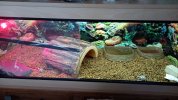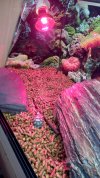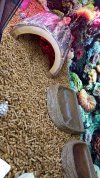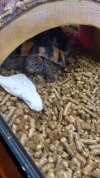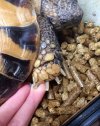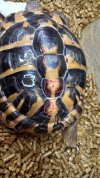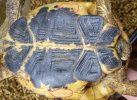Tarz
Member
Hi all (long post apologies)
I have a Hermann tortoise which I have owned for 10 years. Originally the petshop we brought it from said it was mostly likely a male based on the size
It is roughly 12/13 years old now and I have been keeping it in a 4 foot heated vivarium with a heat lamp and UV strip light. Straw pellet bedding.
The UV light is on for 12 hours a day and the heat lamp on 30°C
I've never had any issues within the years of caring for it other than squeaking (which I thought was males just being territorial as there was no runny nose) until recently I had noticed a few concerns.
•squeaking (as mentioned)
•enlarged scales on the feet
•flakey sides of shell
After making an initial appointment with the vet I had also noticed that it seems to be constipated. On some days eating normally and other days hardly eating at all. It has not passed any faeces for a week so far. Last time this happened a few warm baths did the trick but as of yet it hasn't worked.
I was told that I wouldn't need to take it to the vets as often as a dog or cat. Though I know 10 years is far too long to wait.
During the check up I was told it is in fact a female. The squeaking and other concerns I had were dismissed as nothing. There is no runny nose or watery eyes to suggest a respiratory infection so the squeaking was said to be nothing. I was advised to look into changing the vivarium for a tortoise table too. Which I do plan on saving up for.
An ultrasound was taken and I was informed that the ovaries were surrounded with fluid and there were particles covering the ovaries that are enlarged. (I don't remember the specific name of what the tissue around the ovaries were called)
I was also advised to come back in 2 months to see if the ovaries improved and if not then an operation may be the only option.
She said that it has grown slightly too quick in size for her age because she hasn't been hibernated but overall it wasn't a concern. Although I was stilI advised that I should start hibernating the tortoise.
I was told when I had first brought her that I should avoid hibernating as it can cause too many complications. As long as I can provide the right heat and UV conditions I wouldn't need to hibernate.
As I have never hibernated her before I read the leaflet the vet gave me and it said that I should starve the tortoise for 4 weeks, reduce the heat and UV gradually before putting it in the fridge
It was a shock to me
I understand the need for the fridge to regulate the temperature but to suddenly starve a tortoise for 4 weeks seems so harsh and cruel
I understand in the wild they have no choice but to do this to survive, but in captivity it is different
Before the visit to the vets she was slightly lethargic but still moving around and I had put that down to not having any bowel movements
Though after being told she has ovary problems this could also be the cause
However since coming back from the vets she has stayed in hiding and only came out to eat a small amount of food before going back under her log
The vets I visited were a specialist Reptile vets.
I am looking for a second opinion/experience as I fear that having never hibernating her and the age she is now that if I force her into hibernating she will not survive it
I also have concerns as the vets didn't give me any advice on her not pooping
And lastly she seems alot worse after visiting
She had her beak and claws trimmed and her ultrasound done in another room
Usually eating Cuttlefish bone would naturally keep her break worn down but she has refused to eat it for a long while now
I'm not suggesting they have caused her to become more ill but she seems to have become worse
I expect her to be slightly shook up after her visit but it's been a whole day of her not walking around which is unusual for her
Any advise is much appreciated
If you need more info please ask
I have a Hermann tortoise which I have owned for 10 years. Originally the petshop we brought it from said it was mostly likely a male based on the size
It is roughly 12/13 years old now and I have been keeping it in a 4 foot heated vivarium with a heat lamp and UV strip light. Straw pellet bedding.
The UV light is on for 12 hours a day and the heat lamp on 30°C
I've never had any issues within the years of caring for it other than squeaking (which I thought was males just being territorial as there was no runny nose) until recently I had noticed a few concerns.
•squeaking (as mentioned)
•enlarged scales on the feet
•flakey sides of shell
After making an initial appointment with the vet I had also noticed that it seems to be constipated. On some days eating normally and other days hardly eating at all. It has not passed any faeces for a week so far. Last time this happened a few warm baths did the trick but as of yet it hasn't worked.
I was told that I wouldn't need to take it to the vets as often as a dog or cat. Though I know 10 years is far too long to wait.
During the check up I was told it is in fact a female. The squeaking and other concerns I had were dismissed as nothing. There is no runny nose or watery eyes to suggest a respiratory infection so the squeaking was said to be nothing. I was advised to look into changing the vivarium for a tortoise table too. Which I do plan on saving up for.
An ultrasound was taken and I was informed that the ovaries were surrounded with fluid and there were particles covering the ovaries that are enlarged. (I don't remember the specific name of what the tissue around the ovaries were called)
I was also advised to come back in 2 months to see if the ovaries improved and if not then an operation may be the only option.
She said that it has grown slightly too quick in size for her age because she hasn't been hibernated but overall it wasn't a concern. Although I was stilI advised that I should start hibernating the tortoise.
I was told when I had first brought her that I should avoid hibernating as it can cause too many complications. As long as I can provide the right heat and UV conditions I wouldn't need to hibernate.
As I have never hibernated her before I read the leaflet the vet gave me and it said that I should starve the tortoise for 4 weeks, reduce the heat and UV gradually before putting it in the fridge
It was a shock to me
I understand the need for the fridge to regulate the temperature but to suddenly starve a tortoise for 4 weeks seems so harsh and cruel
I understand in the wild they have no choice but to do this to survive, but in captivity it is different
Before the visit to the vets she was slightly lethargic but still moving around and I had put that down to not having any bowel movements
Though after being told she has ovary problems this could also be the cause
However since coming back from the vets she has stayed in hiding and only came out to eat a small amount of food before going back under her log
The vets I visited were a specialist Reptile vets.
I am looking for a second opinion/experience as I fear that having never hibernating her and the age she is now that if I force her into hibernating she will not survive it
I also have concerns as the vets didn't give me any advice on her not pooping
And lastly she seems alot worse after visiting
She had her beak and claws trimmed and her ultrasound done in another room
Usually eating Cuttlefish bone would naturally keep her break worn down but she has refused to eat it for a long while now
I'm not suggesting they have caused her to become more ill but she seems to have become worse
I expect her to be slightly shook up after her visit but it's been a whole day of her not walking around which is unusual for her
Any advise is much appreciated
If you need more info please ask
